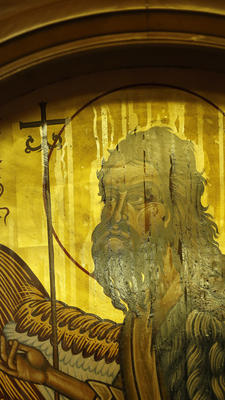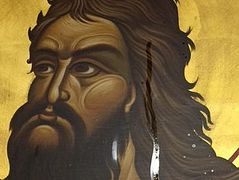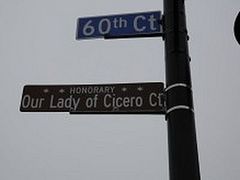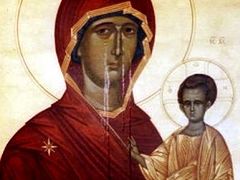Source: Chicago Tribune
April 28, 2016
 The icon of St. John the Baptist inside of Assumption Greek Orthodox Church in Homer Glen has been dripping fragrant oil since July, parishioners said. (Jose M. Osorio / Chicago Tribune)
The icon of St. John the Baptist inside of Assumption Greek Orthodox Church in Homer Glen has been dripping fragrant oil since July, parishioners said. (Jose M. Osorio / Chicago Tribune)
As millions of Orthodox Christians around the world prepare to celebrate Easter this Sunday and the miracle of Jesus Christ's resurrection, thousands across the Chicago area are flocking to a southwest suburban parish to see what they believe to be a different miracle.
Since July, tiny droplets of fragrant oil have trickled down an icon of St. John the Baptist in front of the altar at Assumption Greek Orthodox Church in Homer Glen. Parishioners believe the oil has healing properties and that its origins are a blessing from God.
"The first thing out of my mouth was 'What do I do?' " said the Rev. Sotirios "Sam" Dimitriou, the parish priest. "You don't expect anything like this. It's breathtaking. It's so powerful to see such an act of God before your eyes."
Whether it's an act of God or a chemical reaction, no one really knows. And frankly, few in the Greek Orthodox community care. A rational explanation is irrelevant if what seems to be a supernatural event draws people toward God, clergy say.
"We don't necessarily make official pronouncements on these things," said Bishop Demetrios, auxiliary bishop of Mokissos of the Greek Orthodox Metropolis of Chicago. "We let the faithful believe it if they wish. … If it brings you closer to God that's wonderful. If it doesn't, it doesn't."
The oil, which parishioners believe to be myrrh, exudes from the icon's halo, wings, hands and beard. Collected every week by a reservoir of cotton at the base of the icon, Dimitriou regularly extracts the oil into a pitcher, then saturates cotton balls, which he seals in plastic bags for parishioners to take home and share with their loved ones. So far, he has handed out more than 5,000 samples — a handy way to track the flow of pilgrims.
While Dimitriou certainly does not mind sharing the oil, he has been reluctant to broadcast its origins. Instead, news of the icon has spread by word of mouth.
Reports of the oil's healing effects have made their way to Dimitriou. One man reportedly went to the doctor concerning a blockage in his artery, but it had disappeared. Another reports being cancer free after touching the oil.
The painter of the icon, Peter Mihalopoulos, said he believed the oil was the reason why he was in his garage painting two days after a hip replacement.
Dimitriou himself, who before the oil began to flow, frequently passed out at the altar or in his office because of nerve damage, said he has not been hospitalized for his nerve condition since September and he stopped taking his medication in January.
This is not the first time unexplained streaks of moisture have been spotted on an icon in the Chicago area.
A weeping icon of Mary has drawn huge crowds to St. Nicholas Albanian Orthodox Church several separate times since it began to emit moisture in December 1986. In 1994, parishioners at St. George Antiochian Orthodox Church in Cicero said they witnessed tears streaming from the eyes of Mary in an icon of the Virgin Mary and Baby Jesus.
Unlike those weeping icons, Dimitriou said the oil on St. John the Baptist appears to come from everywhere but his eyes. He has been told that means the icon offers a sign of joy, not sadness.
The fact that it's an icon of St. John the Baptist, also sets it apart. John Price, a 20-year-old altar server, noticed the droplets of oil on the icon, as he held a flickering candle during a Sunday service in July.
Sitting in the front chair that morning, his mother Miki noticed her son transfixed. When he told her later what he had witnessed, she immediately went back to the church to see for herself. "That's my son's saint, and my son wants to be a priest," Miki Price said. "It totally blesses me that John was the first to see it."
James Skedros, dean of Holy Cross Greek Orthodox School of Theology in Brookline, Mass., said that although icons don't exude oil every day, similar episodes have taken place across the U.S. There is no formal process in the Orthodox church of authenticating such incidents as miracles, he said, but they are believed to hold significance.
Just as Christians believe God broke into the physical world with his incarnation 2,000 years ago, Orthodox Christians believe that matter can be a conveyor of sanctity, he said.
"We have a very different understanding of matter as a vehicle of holiness so we treat icons in that matter," Skedros said. "We put them on walls, burn candles in front of them, light incense in front of them because they're images of what they represent — the holy person or image of Christ or the saint."
Could the phenomenon be attributed to a reaction to the church's environment? Of course, Skedros said. But why go there? What bishop wants to question the congregation, discredit a priest or doubt God?
Indeed, Bishop Demetrios sees the rivulets of oil and powerful perfume emanating from the icon as a blessing for a wounded congregation.
In 2007, the Greek Orthodox Archdiocese suspended a former priest over allegations he sexually abused minors in the early 1970s while he was a priest at Assumption, when it was located in Olympia Fields.The parish eventually moved to Homer Glen in 2013.
"God through this icon is somehow healing this parish from some serious hurt in its past," Bishop Demetrios said.
Helen Conits, who joined the parish this week, said the icon has offered her comfort and peace of mind. On Wednesday, she came to the church to be anointed with oil in the sacrament of holy unction and to pick up a cotton ball for her ailing father and her daughter.
"I do believe in miracles," she said. "I don't necessarily have to see it but it's nice. At a time when everything seems to be falling apart in the world and for us personally, it's nice to see."
Dimitriou said the potential for crowds does make him nervous but it's stories like Conits' that remind him what a blessing the icon offers to the world.
"When people see this, it's just a reminder that God is still alive and still working through us and it's a reminder that there's still hope in the world for us," he said.
Pamela Arvanetes, a parishioner at Sts. Constantine & Helen Greek Orthodox Church in Palos Hills, brought her five children to venerate the icon Wednesday.
"I wanted them to witness it," she said, "an extra blessing, the symbol of our faith, a miracle."



